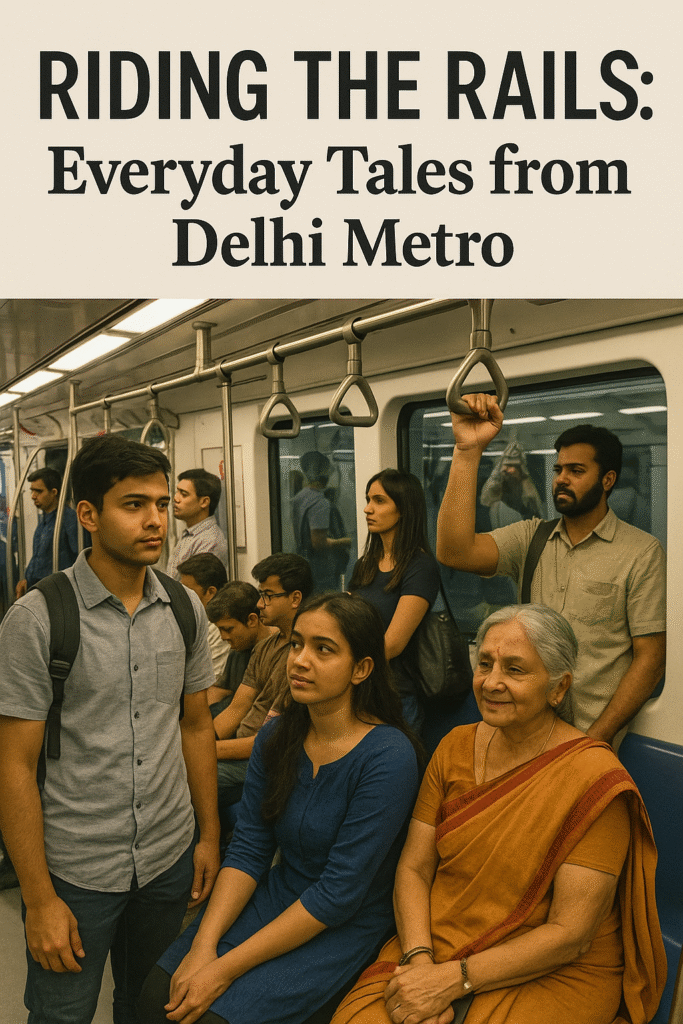In the heart of Delhi, beyond the traffic jams and noisy roads, runs a lifeline that millions depend on every day — the Delhi Metro. It’s not just a network of steel tracks and stations. It’s where the city breathes, thinks, and moves. Every compartment holds hundreds of lives, and with them, hundreds of untold stories.
Each morning, as the city wakes up, the metro fills with people heading toward colleges, offices, and schools. Some stand silently with headphones on, some scroll through their phones, others doze off while holding onto the overhead bars. Yet despite the differences in backgrounds, destinations, and dreams, there’s an invisible thread that ties them together. They’re all part of this giant rhythm, this silent routine that defines urban life.
Among them is Arjun, a young student from Dwarka who travels nearly two hours to Noida every day. He says he’s made “metro friends” — people he never speaks to but sees every morning. They nod at each other, sometimes smile, and somehow, this quiet companionship makes the long journey feel shorter. It’s a simple kind of human connection — one that needs no words.
Every train has its observers. They’re the ones who take a seat by the window and watch the world inside and outside go by. Some stare at nothing in particular, lost in thought. Some notice everything — the way someone nervously taps their foot before an interview, or how a mother soothes her baby with soft songs. One of them is Aarti, a retired teacher. She travels every week to meet her daughter and loves watching the mix of people around her. “It’s like watching a hundred little films at once,” she says. “Everyone has their own story.”
Then there’s the women’s coach — a space that has become more than just a compartment. It’s a comfort zone. Women laugh, share food, give each other beauty tips, and help fellow travelers with bags or directions. It’s not unusual to see a young girl talking to an elderly lady about her college life or someone passing a crying baby around to calm it. For many women, this space offers not just safety, but a sense of sisterhood.
In between stations, performers often step in — singers with soulful voices, children with acts that last just a minute, hoping for a few coins. You may also find a bookseller, a man with handmade toys, or someone simply offering words of motivation. These little interactions, often brief and unnoticed, are reminders of how creative and hopeful people remain despite struggles.
Evening time tells a different tale. People return from work, exhausted and eager to reach home. The trains are more crowded, the energy a bit more tense. Yet, even in that packed space, acts of kindness happen. Someone gives up their seat for an elderly person, a stranger helps carry a bag, or a quick apology softens a bump. Delhi Metro might be rushed and noisy at times, but it teaches patience and silent respect among strangers.
Metro stations themselves are like chapters in a book. Rajiv Chowk is fast and chaotic, Hauz Khas is artistic and young, Karol Bagh smells of old Delhi, and Central Secretariat is serious and filled with officials. People meet, part ways, wait for loved ones, or simply sit and breathe in between journeys. The escalators, platforms, and corridors all witness small moments that are as human as they are meaningful — a goodbye hug, a chance encounter, or a shared laugh between friends.
More than anything, the Delhi Metro shows us that city life isn’t always cold or distant. It teaches silent empathy. No one knows the person next to them, but they give space, respect, and sometimes, a helping hand. In a world that feels fast and disconnected, the metro brings people closer, even if they never speak.
It’s a place where dreams ride alongside deadlines. A girl sketches in her notebook as the train rattles along. A man clutches a folder, rehearsing answers for an interview. A grandmother, dressed in a bright sari, smiles quietly, thinking of her grandchildren. Everyone is going somewhere, not just in distance, but in life.
What makes the metro so special isn’t just its clean coaches, fast service, or wide reach. It’s the people. The daily crowd that fills it with life, emotion, and unspoken understanding. It’s a space where people from every walk of life come together, even if only for a few stops.
The Delhi Metro has become more than just a way to get around. It is the city’s moving heart. It carries not just passengers, but their worries, hopes, and moments. And if you look closely during your next ride, you might just find a story waiting in the seat next to yours — or maybe even your own, unfolding one station at a time.

